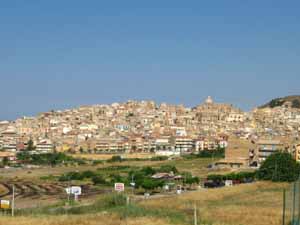 Last year -- when y'all were presumably going through rogueclassicism withdrawal -- I was spending most of my time in a farmhouse outside of this paese of Siculiana. This will be the first in a series of posts on items which should be of interest (hopefully) to readers of rogueclassism. While there are scattered bits of info about Siculiana (mostly touristy in nature) abounding on the web, I have found the most useful reference on the history of the place to be Paolo Fiorentino, Siculiana Racconta, and some of what follows derives from his booklet.
Last year -- when y'all were presumably going through rogueclassicism withdrawal -- I was spending most of my time in a farmhouse outside of this paese of Siculiana. This will be the first in a series of posts on items which should be of interest (hopefully) to readers of rogueclassism. While there are scattered bits of info about Siculiana (mostly touristy in nature) abounding on the web, I have found the most useful reference on the history of the place to be Paolo Fiorentino, Siculiana Racconta, and some of what follows derives from his booklet.Siculiana is about 13 km down the coast from Agrigento and currently has a population of about 5000. It's the paese where my wife and all her kin were born (she was actually born in one of the houses in the photo) and her uncle maintains a small farm outside the village. Among other things, the town boasts a nice baroque-style church (about which there will be more below and in a subsequent post) and a small castello (ditto).
There are a number of theories about whence derives the name "Siculiana". I'm sure most readers of this blog immediately thought that it derives from something like Siculi Janua ("Sicily's Doorway" ... as I did) and that indeed is one of the suggested etymologies. There is, however, another suggestion: the aforementioned castello was established in 1310 and built on the remains of an Arab fortress which had been known as Kalat Sugul and had been destroyed in 1087. From this, it is suggested that the name of the fortress took its name from Suq-al-Jani (i.e. Johnny's Market) or Suqu-'l-yuni or Suqu-'l-yunani (the Greek Market).
More interesting for our purposes is the claim that Siculiana is the site of the ancient town of Camico, the seat of King Kokalos whither Daedalus landed after his son went plop in the sea. Several towns in the area have been proposed as the site -- and indeed, there are scattered signs promoting the regions as the Kingdom of Kokalos (although it doesn't seem to be a 'major' promotion, despite legends that there is a 'treasure of Kokalos' somewhere in the area) -- but Siculiana does seem to have the best claim based on geography and scattered bits of later documentary evidence. The town has also been identified with Herbessos (which surrendered to Marcellus in 213 B.C.) and with what is listed as Cena on the Antonine Itinerary.
Despite this apparently ancient pedigree, however, there really isn't much 'ancient' to be found in the town, alas. Down the road, in Realmonte, there is an excavation of a Roman villa in progress but it is strikingly odd that there are no similar digs going on or structures already found in the environs of Siculiana. Fiorentino's aforementioned book has an undated, grainy photo of an "ancient" paved road going through some farmer's field, but it doesn't look Roman. There are tales of farmers and the like hitting what appear to be foundations while building their own buildings and/or farming, but they are quickly covered up out of fear of expropriation (cf., e.g, that news item a few weeks ago about a 'rescued' temple). Even so, various folks have found scattered items of interest (coins, etc.) which I'll hopefully be able to share with you in a subsequent post.
